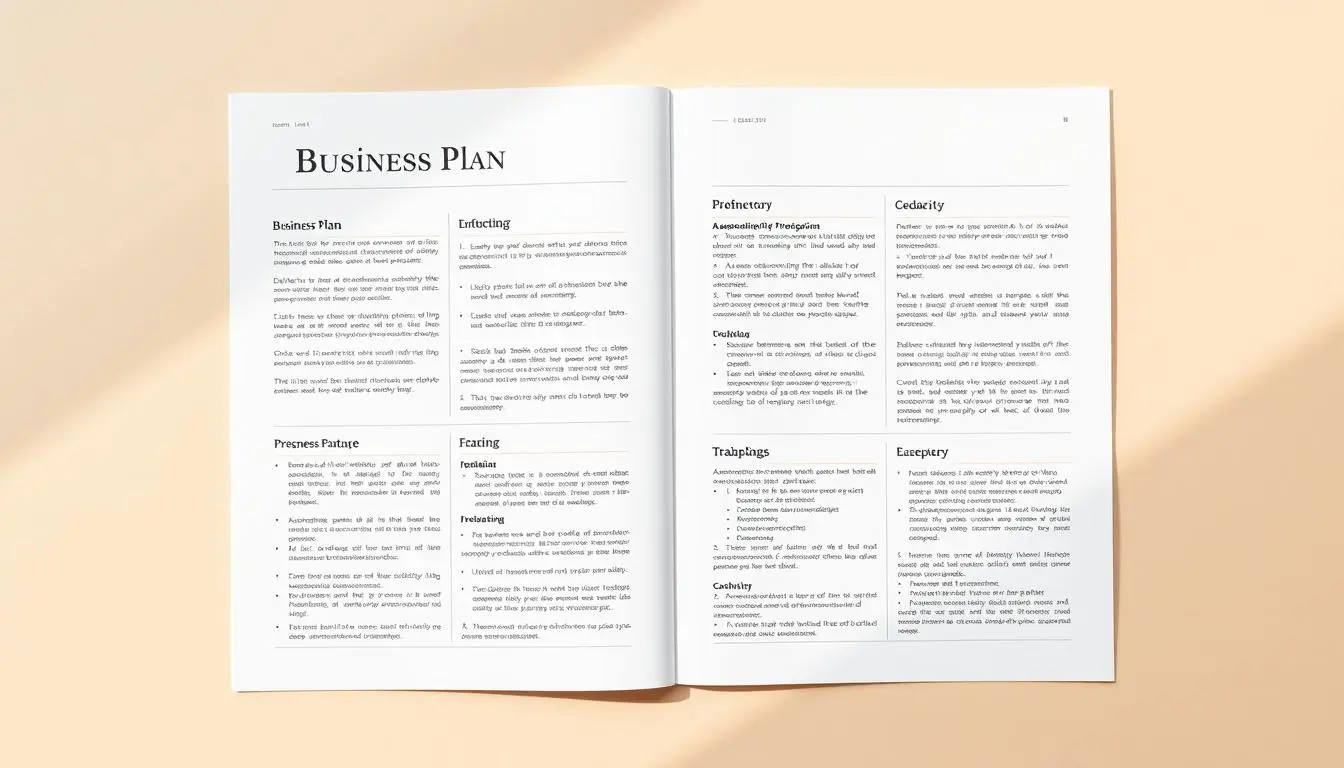How to Write a Business Plan
Launching a business is thrilling, but it requires a well-thought-out strategy to thrive. Think of a business plan as your roadmap; it guides every step toward your objectives. It guides you through tough times and helps you reach your goals.

Studies show how important a business plan is. A study found that companies with a plan grow 30% faster. This shows how valuable it is to spend time on a detailed plan.
Table of Contents
What Is a Business Plan and Why Do You Need One?
Creating a business plan is a key step to make your business idea a reality. It outlines your business’s purpose, how it makes money, and who it serves. It acts as a roadmap, helping you stay focused and make smart choices.
It helps you organize your business from the inside. It also shows lenders and investors your business’s growth and profit chances.
The Purpose of a Business Plan
A business plan is your business’s roadmap. It outlines your vision, actionable steps, and financial projections in one cohesive document. This document provides a snapshot of your current operations and future aspirations.
Key Benefits for Startups and Established Businesses
Whether you’re a startup or an existing company, a business plan keeps you aligned and focused. For new ones, they help get funding and start operations. For those already up and running, they help with planning and finding new chances.
| Benefits | Startups | Established Businesses |
|---|---|---|
| Securing Funding | Essential for initial investment | Helps in expansion and growth |
| Strategic Planning | Guides initial operations | Aids in identifying new opportunities |
| Risk Management | Helps mitigate initial risks | Assists in managing growth-related risks |
Knowing why a business plan is important helps you make an easy business plan guide. You can follow a basic business plan format that’s easy to understand and effective.
Understanding the Components of a Simple Business Plan Template
A well-structured template is essential for turning your business ambitions into reality. It outlines your strategy, objectives, and the steps to success.
Creating a business plan means knowing its key parts. A typical plan is 15-20 pages. It explains your business, goals, and how you’ll achieve them.
Essential Elements vs. Optional Sections
Every effective business plan should include core sections like an overview, market insights, and financial details. Don’t overlook critical components like promotional tactics, budget forecasts, and capital requirements. Optional parts might include market research and product descriptions.
| Essential Elements | Description |
|---|---|
| Executive Summary | Overview of your business plan |
| Company Description | Details about your business structure and mission |
| Market Analysis | Analysis of your target market and competitors |
Tailoring Your Plan to Your Business Type
Your plan should fit your business type. Startups might focus on market research. Established businesses might look at financial growth.
Special Considerations for E-commerce Businesses
E-commerce businesses need a special plan. This includes digital marketing and online sales. Your plan should outline success in the online world.
By knowing your business plan’s parts and tailoring it, you can make a straightforward business outline. This helps you reach your goals.

Getting Started: Preparation Before Writing
A solid business plan starts with preparation. This includes research and setting clear goals. It’s best to write your plan after you’ve researched your idea. If things change, you can always update it.
Research You Need to Conduct
To create a simple business strategy, you must do deep market research. Dive deep into audience demographics, analyze rival brands, and track evolving market shifts.
- Identify your target market and customer segments
- Analyze competitors and their strategies
- Outpace competitors by anticipating market trends and seizing overlooked opportunities
Information to Gather
It’s important to gather the right data for your business plan. You should look into:
- Market size and growth
- What customers want and need
- Evaluate where rivals thrive and struggle to fine-tune your competitive strategy
Setting Clear Objectives
Clear goals give your plan direction. Set goals that are clear, trackable, realistic, aligned with your mission, and time-bound. This keeps you focused and makes your plan effective.
Crafting Your Executive Summary
The executive summary captures your business plan’s essence in a brief, impactful snapshot. It shows investors what matters most. Imagine it as a pitch to potential backers, your chance to make a lasting impact.
What to Include in This Critical Section
Your executive summary should be short but cover the basics. Highlight your mission, product lineup, ideal customers, and revenue expectations. Make sure it fits the needs of your audience, like investors or lenders.
Key components to include:
- A brief overview of your business concept
- Market opportunity and competitive landscape
- Your unique value proposition
- Summary of financial projections and funding requirements
Writing Tips for Maximum Impact
To make your summary stand out, keep it clear and to the point. Use simple words to explain complex ideas. Stay away from jargon that might confuse your readers.
Common Executive Summary Mistakes to Avoid
Don’t write your summary first. It should reflect your business plan accurately. Also, avoid being too vague. Your summary should show what makes your business unique.
| Mistake | Correction |
|---|---|
| Writing the executive summary first | Write it last to ensure it accurately reflects your business plan |
| Being too vague | Provide specific details about your business and market |
| Ignoring your audience | Tailor your summary to the interests and concerns of your readers |
By avoiding these mistakes and using a no-fuss business planning template, you can craft a summary that truly captures your business’s essence. This approach will also connect deeply with your intended market.
Developing Your Company Description
A compelling company overview should articulate your purpose, offerings, audience, and financial health. It gives an overview of your business. This includes its structure, mission, and vision.
Defining Your Business Structure
Begin your company description by explaining your legal and operational setup. You might be a sole proprietorship, partnership, LLC, or corporation. Establish clear ownership structures and define critical stakeholder roles upfront.
Key elements to include:
- Business registration details
- Names of key personnel
- Ownership percentages
Articulating Your Mission and Vision
Make sure to clearly state your business’s mission and vision. Your mission statement should outline your purpose and main goals. Your vision statement should reflect where you see your company in the years ahead.
Example: “Our mission is to provide high-quality products while ensuring customer satisfaction.”

Highlighting Your Unique Value Proposition
Your unique value proposition (UVP) explains what makes your business stand out. Identify your Unique Value Proposition (UVP) and highlight it prominently in your business summary.
Consider the following:
- What makes your product or service unique?
- What customer challenges does your product or service address?
- What benefits do you offer that others don’t?
Market Analysis: Understanding Your Industry and Competitors
Doing a market analysis helps you see where you stand in your industry. It’s key to making smart choices. You’ll uncover valuable knowledge about your industry, customers, and rivals.
Conducting Effective Market Research
Effective market research starts with analyzing industry dynamics and growth potential. Look at its size, how it’s growing, and who’s leading it. These findings reveal gaps and opportunities for your brand to capitalize on. Leverage industry reports, case studies, and digital analytics tools for accurate data.
Key areas to focus on include:
- Industry size and growth rate
- Trends and outlook
- Major competitors and their market share
Identifying Target Customer Segments
Focusing sharply on your most valuable customers can accelerate scalable growth. Recognizing customer frustrations and habits is key to achieving meaningful growth. Study their demographics, purchasing habits, and feedback on your offerings.
When defining your target market, evaluate these key criteria:
- Demographic characteristics (age, gender, income)
- Psychographic characteristics (interests, values, lifestyle)
- Behavioral patterns (purchasing habits, brand loyalty)
Analyzing Competitors and Market Trends
Understanding your competitors is important. Know their strengths, weaknesses, and plans. This shows you where you can stand out. Stay adaptable by continuously tracking market shifts and adjusting strategies accordingly.
Investors seek clarity on what differentiates your product from competitors. In your competitive analysis, assess rivals’ advantages and where you outperform them.
By doing a detailed market analysis, you’ll get a better grasp of your industry and rivals. This will make your business plan stronger and boost your e-commerce success.
Creating Your Marketing and Sales Strategy
A strategic marketing and sales plan ensures you connect with and retain customers effectively. Tailor your approach by studying customer preferences, behaviors, and motivations.
Developing Your Marketing Plan
A good marketing plan shows how you’ll share your products or services. Explore diverse tactics, from paid search ads to social media outreach and direct marketing.
- Determine your primary audience and the digital spaces they frequent most.
- Set clear marketing objectives and budget allocations.
- Choose the most effective marketing tactics for your business.

Outlining Your Sales Process
Your sales process should turn leads into customers efficiently. Map out the customer journey from first interaction to final purchase.
| Sales Stage | Description | Key Activities |
|---|---|---|
| Prospecting | Identifying possible customers | Research, lead generation |
| Qualifying | Checking if leads are good | Needs assessment, initial contact |
| Closing | Finalizing the sale | Negotiation, agreement |
Digital Marketing Strategies for Modern Businesses
In today’s digital-first era, a strong online presence is essential for survival. This means using social media marketing, email marketing, and search engine optimization (SEO) to connect with your audience.
By using these strategies in your marketing and sales plan, you can effectively reach and engage your target audience. This drives sales and growth for your business.
Financial Projections and Funding Requirements
To attract investors and ensure your business lasts, you need to make accurate financial forecasts. Understanding your funding needs is key. A detailed financial section in your business plan is vital for getting investments and reaching profitability.
Creating Realistic Financial Forecasts
A detailed sales forecast can get investors excited about your business. It’s a table or simple graph showing your sales over time. To make a realistic forecast, use historical data, market trends, and seasonal changes.
Key components of a sales forecast include:
- Projected revenue
- Sales volume
- Pricing strategy
- Market growth rate
Income Statements, Balance Sheets, and Cash Flow Statements
Understanding and preparing key financial statements is essential. These documents give a full view of your company’s financial health. They help in making smart decisions.
Here’s a quick breakdown of these essential financial records:
| Financial Statement | Description | Purpose |
|---|---|---|
| Income Statement | Shows revenues and expenses over a period | Assesses profitability |
| Balance Sheet | Provides a snapshot of assets, liabilities, and equity at a specific point | Evaluates financial position |
| Cash Flow Statement | Monitors financial inflows and outflows to maintain stability | Monitors liquidity |
Determining Your Funding Needs
Calculate your funding requirements by evaluating operational and growth expenses. This means calculating startup costs, ongoing expenses, and revenue.
Consider the following when determining funding needs:
- Initial investment costs
- Ongoing operational expenses
- Projected revenue and cash flow
- Growth plans and expansion costs
By accurately assessing these factors, you can find out how much funding you need to start and keep your business going.
Our Free, Intuitive Business Plan Template: Your Roadmap to Success
Our minimalist business plan layout makes creating a clear business plan easy. Our template helps you draft your business vision and action plan efficiently.
Template Overview and Features
The template offers a straightforward business outline that covers key business aspects. It includes structured segments for summaries, company details, market insights, and more.
Customization Guidelines
Maximize the template’s value by tailoring it to your unique business model. Start by reviewing each section and adjusting the content to fit your business’s unique needs.
Tips for Filling Each Section Effectively
When filling out the template, aim for clear and concise info. In the executive summary, focus on your business’s main goals and mission. In your market analysis, incorporate insights on customer segments and rival brands.
Adapting the Template for Online Businesses
If you run an online business, you’ll need to adjust some sections. Expand on your digital outreach strategies and online sales processes.
By following these tips and using our simple business plan template, you can create a detailed plan. This roadmap will steer you toward achieving your entrepreneurial goals.
Conclusion: Putting Your Business Plan into Action
Creating a business plan is just the beginning. You now have a roadmap for your business decisions. Even a flexible plan provides direction, increasing your chances of success.
Your business plan should adapt as your company grows and changes. Regular updates help you stay on track and make smart decisions. By executing your strategy, you’ll navigate obstacles and seize growth opportunities.
Now, take the leap and transform your entrepreneurial vision into action. Use your plan to drive growth and improve operations. A well-crafted plan lays the groundwork for sustained success and scalability.
FAQ
What is the primary purpose of a business plan?
A business plan outlines your goals and strategies. It acts as a roadmap for success. It also helps secure funding or investment.
How often should I update my business plan?
Update your plan every six to twelve months. Or whenever big changes happen in your business or market.
Can a simple business plan template work for an e-commerce business?
Yes, a simple template can work for e-commerce. Focus on online marketing, digital sales, and logistics.
What are the essential elements of a business plan?
Key elements include an executive summary and company description. Also, market analysis, marketing strategy, financial projections, and funding needs.
How do I conduct effective market research for my business plan?
Gather data on your target audience and analyze trends. Use online tools, surveys, and reports to assess competitors.
What is the importance of a unique value proposition in a business plan?
A unique value proposition is key. It shows your competitive edge and what sets you apart from others.
How do I determine my business’s funding needs?
Create realistic financial forecasts and assess cash flow. Consider operational costs, growth plans, and risks.
Can I use a business plan template for a startup and an established business?
Yes, templates work for both startups and established businesses. The focus and content will vary based on your business’s needs.
What are the key financial statements to include in a business plan?
Key financial documents include Profit & Loss Statements, Balance Sheets, and Cash Flow Reports. They give a full view of your financial health.
How do I make my executive summary impactful?
Make your summary clear and concise. Highlight your unique value, key objectives, and competitive edge.







